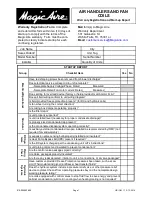
Section 9. Ductwork
Field ductwork must comply with the National Fire Protection Association NFPA 90A, NFPA 90B and any applicable
local ordinance.
WARNING
Do not, under any circumstances, connect return ductwork to any other heat producing device such as
fireplace insert, stove, etc. Unauthorized use of such devices may result in fire, carbon monoxide poisoning,
explosion, personal injury or property damage.
Sheet metal ductwork run in unconditioned spaces must be insulated and covered with a vapor barrier. Fibrous
ductwork may be used if constructed and installed in accordance with SMACNA Construction Standard on Fibrous
Glass Ducts. Ductwork must comply with National Fire Protection Association as tested by U/L Standard 181 for Class I
Air Ducts. Check local codes for requirements on ductwork and insulation.
•
Duct system must be designed within the range of external static pressure the unit is designed to operate against. It
is important that the system airflow be adequate. Make sure supply and return ductwork, grills, special filters,
accessories, etc. are accounted for in total resistance. See airflow performance tables in this manual.
•
•
Supply plenum is attached to the 3/4” duct flanges supplied with the unit. Attach flanges around the blower
outlet.
IMPORTANT:
If an elbow is included in the plenum close to the unit, it must not be smaller than the dimensions of
the supply duct flange on the unit.
•
IMPORTANT:
The front flange on the return duct if connected to the blower casing must not be screwed into the
area where the power wiring is located. Drills or sharp screw points can damage insulation on wires located inside
unit.
• Secure the supply and return ductwork to the unit flanges, using proper fasteners for the type of duct used and
tape the duct-to-unit joint as required to prevent air leaks.
The air distribution system has the greatest effect on airflow. The duct system is totally controlled by the contractor. For
this reason, the contractor should use only industry-recognized procedures.
Heat pump systems require a specified airflow. Each ton of cooling requires between 350 and 450 cubic feet of air per
minute (CFM), or 400 CFM nominally.
Duct design and construction should be carefully done. System performance can be lowered dramatically through bad
planning or workmanship.
Air supply diffusers must be selected and located carefully. They must be sized and positoined to deliver treated air
along the perimerter of the space. If they are too small for their intended airflow, they become noisy. If they are not
located properly, they cause drafts. Reture air grilles must be properly sized to carry air back to the blower.If they are too
small, they also cause noise.
The installers should balance the air distribution system to ensure proper quiet airflow to all rooms in the home. This
ensures a comfortable living space.
An air velocity meter or airflow hood can give a reading of system CFM.
12
Design the duct system in accordance with “ACCA” Manual “0” Design for Residential Winter and Summer Air
Conditioning and Equipment Selection. Latest editions are available from: “ACCA” Air Conditioning Contractors of
America, 1513 16th Street, N.W., Washington, D.C. 20036. If duct system incorporates flexible air duct, be sure
pressure drop Information (straight length plus all turns) shown in “ACCA” Manual “D” is accounted for in system.



































